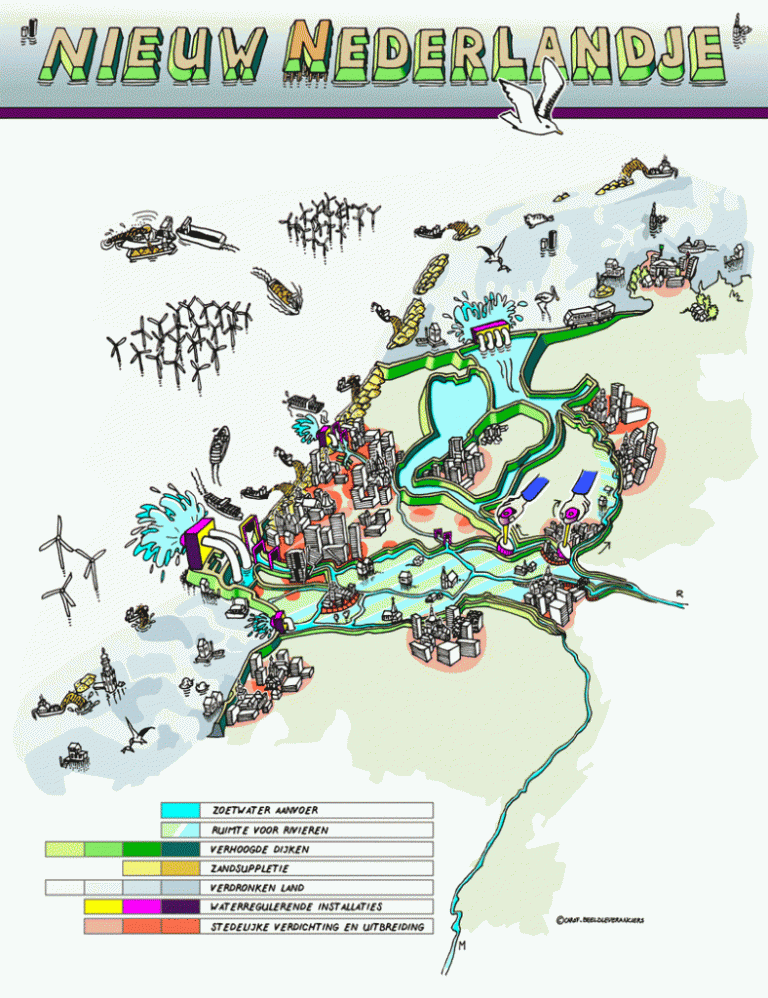The sea level may well be rising much faster than scenarios suggest. If this is so, the current measures will be inadequate to keep our feet dry. Is it time for radical plan.
The Dutch Waddenzee
People have been afraid of floods since time immemorial. The oldest stories are to be found in Genesis and relate how Noah and his ark were saved while the rest of creation was swept away. Countless writings, etchings and paintings testify to the destructive power of water. People learnt to live with water, but they remained wary of it.
All, that is, except the Dutch in the second half of the twentieth century. They grew up in safety behind their Delta Works, a monumental barrier against the sea that drew hydrological engineers from all over the world and was long a source of Dutch pride and identity. Problems with floods? Call in the Dutch. They’ll fix it! Today this confidence is starting to crumble, and the age-old fear of flooding is trickling back.
Sea level rise accelerating
“When I started researching the effects of climate change in 1990, we thought I was studying a scenario that lay far in the future. Today we have realised that the sea level may be rising much faster than we thought and that drastic measures may need to be taken as early as 2050. My children will be just as old as I am now then.” The speaker is Dr Marjolijn Haasnoot, climate and water researcher at Deltares and Utrecht University. She is the lead author of a report entitled ‘Potential effects of accelerated sea level rise on the Delta programme’ (Deltares, September 2018).
The first sentence says it all: “The sea level could rise much faster than was assumed up to now in the Delta programme.” The reason for this is the recent discovery that the land ice on the South Pole is also melting; up to now, it was assumed that climate change barely manifested on Antarctica. Now it turns out that the glaciers there are being undermined by warm sea water, causing them to retreat.
On top of this, it seems unlikely that the temperature increase will be limited to 2 degrees by the end of the current century. In the best-case scenario, if all countries comply with the international agreements, the temperature will rise by 3 degrees, and otherwise even more.
The current Delta scenarios all assume a maximum sea level rise of 1 metre by the end of the century (compared to 1995). According to Haasnoot and her colleagues, however, this could be 2 to 3 metres by 2100 (increase of 4 degrees); and even 5 to 8 metres by 2200, warns Deltares. What does this mean for the Delta programme?
System failure
“We studied the effects of a rise of 2 metres on the Delta programme,” explains Professor of Hydraulic Engineering Bas Jonkman. “That seemed reasonably manageable without major changes to the system. More sand on the coast, stronger dikes, close the storm surge barriers more often; we estimated it would cost €1 billion per year, which is doable.”
But if the water rises even higher, the system will fail. For a rise of 1.2 metres, it will be more effective to replace the Maeslant Barrier with a lock, and above 2.1 metres the Oosterschelde Dam will have to be closed permanently, Deltares has calculated. Technical solutions are available, but it will be extremely expensive and the risks of failure high. Salt water will penetrate the groundwater system and all river water will need to be actively pumped away.

(Illustratie: Carof/Beeldleveranciers)
Radical approach
A radically different approach will be required above a 2-metre rise, and that is exactly what Geert van der Meulen presented in his thesis entitled ‘New Netherlands’. He sketched a fascinating picture of a new ‘Little Netherlands’. In his design, the northern town of Den Helder has become an island and Assen is a seaport. The new Afsluitdijk causeway runs from Medemblik to Lemmer. All the land above is part of the New Wadden Sea. To the southwest, the islands of Zeeland have been replaced by a huge nature reserve. The ‘Green Heart of Holland’ has been completely built over to provide homes for 1.7 million Dutch climate refugees. Half of the Netherlands is surrounded by high dikes and densely populated, the other half is wetland.
Which areas do you need to protect?
Van der Meulen explains that he emulated landscape architect Prof. Dirk Sijmons in that he tried to find where the essential backbone of the country is, and where there is leeway. Which areas with natural, urban, industrial or other heritage do you need to protect and which can you abandon in order to better protect the rest?
His New Netherlands is a starting point from which to reconsider the current Delta programme, says Van der Meulen. “Normally, drastic measures are only taken after a disaster. But sea level rise is a disaster that we know is waiting to happen. There is no need for us to be taken by surprise.”
Predict sea level rise
Haasnoot recommends monitoring the land ice on Greenland and the South Pole and developing calculation models to predict sea level rise more accurately. Bas Jonkman is keen to establish a design studio together with the faculties of Technology, Policy and Management (TPM) and Architecture and the Built Environment to conceive designs for a New Netherlands. He believes that solutions can be found for a sea level rise of up to 10 metres. After that it will be time to evacuate. As Johan van Veen, the father of the Delta plan predicted: “One day with a sigh of relief we will give up this country to the waves.”
Do you have a question or comment about this article?
j.w.wassink@tudelft.nl


Comments are closed.